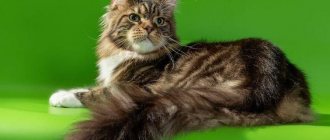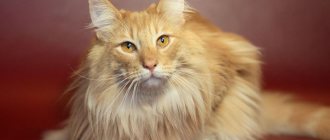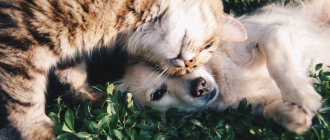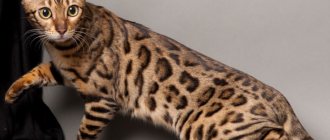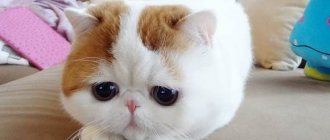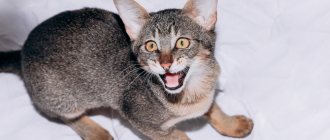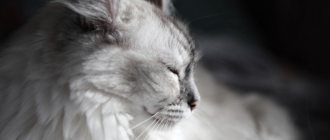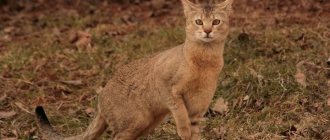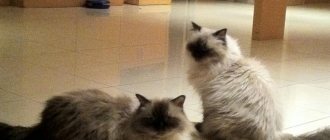Features of black cats
The pigment melanin is responsible for the formation of skin and coat color. There are two types of it: eumelanin and pheomelanin. Both pigments differ in structure.
The grains of the first have a spherical shape, due to which they absorb light and produce black pigment and all its derivatives - chocolate, lilac, blue, fawn. Pheomelanin grains reflect light in the red range and are responsible for this color and all its varieties.
Color is inherited depending on gender, since the gene is located on the X chromosome, it is not on the Y chromosome.
A male with one X chromosome can carry black or red. A female with two X chromosomes carries three color options (red, black, tortoiseshell).
The genes responsible for color are passed on to the son through the maternal line. A black cat cannot produce a red cat, and a red female will never produce a black male.
Character
Black cats have highly developed empathy; they feel the owner’s mood swings, his emotional and physical state. These purrs know how to amuse and heal.
Animals are tolerant of children's antics, are not prone to aggression, easily adapt to circumstances, and quickly recover from stress.
It is generally accepted that blackies are weather sensitive. By observing the behavior of their pets, owners learned to predict weather changes. There are cases when black cats warned their owners about the approaching earthquake. Showing concern, the animals forced people to leave their homes.
Advantages and disadvantages
Advantages:
- flexible disposition;
- responsiveness;
- peacefulness;
- attractive appearance;
- empathy.
Cats with black fur have no objective disadvantages.
Cat colors: what they are and how they are bred
The color of the coat, and this is what should be understood by the color of a cat, is determined by the presence in the structure of the hair of special coloring substances (melanins), whose microscopic grains are present in the hairs in varying quantities, and also have different shapes and sizes.
Eumelanin is responsible for pure black color, the particles of which have an elongated ellipsoidal shape and absorb almost all rays of the spectrum. The synthesis of this pigment is under the control of the B gene (Black - black), which is dominant (suppressive). The saturation of the shade depends on the D gene (Dilutor - diluent). If it is dominant, then the pigment microgranules are packed in the hairs very tightly and closely, so the color of the fur is bright and rich. With the recessive form, there are fewer coloring particles and they are placed more spaciously, which makes the color diluted and faded.
Black color is quite difficult to breed
to obtain an even pitch-colored coat, since both parents must have genes in a dominant position. Most often, the dark color is obtained by accident and is far from ideal. The task of a competent breeder is to correctly select animals for mating in order to obtain the desired result.
For a kitten to be pure black, both parents must also be this color.
The final black shade is not established immediately; kittens often have a lighter undercoat (gray, brownish, etc.). The color changes only after one and a half, and sometimes even two, years of a cat’s life.
The black coat color in cats is not immediately established; small kittens may have a brownish tint
Color options
According to international standards, the black color is assigned the code n (sil, wild, ebony, sable). The guard hairs and undercoat should have a uniform color: each hair is completely dyed, without colored or white inclusions.
The nose, paw pads, and whiskers must be exclusively black.
Possible eye colors
The iris of the eyes often plays with all shades of yellow and green: bright emerald, bright green, orange, olive, light sand.
Reference. Black kittens are born with blue irises.
Turkish van
A cat breed that has been well known to everyone for a long time. The fur is soft, but at the same time waterproof. Color directly depends on the habitat. The weight of the animal can be a maximum of 10 kg. The color white with red spots is very common among this breed. Vans are considered loyal to their owners, and their kind nature is sure to please children.
Top best black cat breeds
There are no exclusively black cat breeds in nature. These include perhaps a variety of Burmese cats - the Mandalay breed. This bright black beauty with piercing yellow eyes has not yet been recognized by international organizations, however, due to the growing popularity of the Burmese, we can expect their official recognition in the near future.
Black colors are found in the following breeds: Maine Coon, British and Scottish cats, American Curl, Bombay, Manx, Chausie, Cymric.
Persians and Egyptian Mau are characterized by smoky colors: the tips of the hairs are dark gray or black, and the base is light.
Bombay
The only cat breed whose standard allows only black color. Externally, the animals resemble a panther. The breed was developed in the USA in the 50s. XX century. The coat should be dark, without streaks or marks. The nose and paw pads are only black.
Kittens are born with blue eyes. As animals mature, the iris turns gray and then acquires a rich golden-amber hue.
Persian
The color variability of Persians is amazing. One of them is raven color, without red. The undercoat is slightly shorter, but the shade is the same. The coat is luxurious, long, iridescent. Paw pads and nose are black-brown or black. The skin has a gray-blue tint. The iris of the eyes is dark orange or deep copper.
The fur is thick and easily tangled, so it needs regular brushing. A lush collar adorns the neck, shoulders and chest.
Devon rex
A young breed of English origin. One of the color options is black with a gray or blue tint. At the same time, the coat is very short, soft, curly, without hard guard hairs. The eyes are slanting, expressive, of any color: golden, green, yellow, hazel, orange, olive.
The black color is also included in other colors: mackerel, silver-black, tabby, bicolor.
American Bobtail
Short-tailed cat of American origin. There are various shades of black: ash, charcoal, dark chocolate. The eyes are large, almond-shaped, hazel, green, and light yellow in color. The nose and paw pads are black or dark brown.
The American Bobtail is closely related to the Kurilian Bobtail. The breed received official recognition in 1989, although the breed characteristics were established in the 60s. gg. XX century. Representatives of the breed have strong bones and a powerful build. The character is flexible, which makes the “Americans” everyone’s favorites.
Norwegian forest
The Norwegian Forest Cat is a real beauty, the national pride of the United States, and has an external resemblance to the Siberian cat. There are numerous colors, but the most spectacular is black. The iris of the eyes can be green, amber, hazel, or golden.
The coat is thick, double, repels water well, the neck is decorated with a “collar”, and the hind limbs are decorated with “socks”.
A fur collar on the neck protects from severe frosts, and powerful paws help to move quickly. The Norwegian Forest loves freedom and is suitable as a companion for those who will not limit its actions.
Manx
Representatives of the breed are born with short tails or without them at all. The coat is two-layered, the black guard hair is lined with a dense dark-colored undercoat. The iris is colored in yellow and orange shades. The nose and paw pads are also black.
The dark color is variable: tabby (dark stripes on gray or fawn), smoky, dark chocolate, dark gray.
Maine Coon
The Maine Coon is a large cat with a long, smooth coat. The black color is deep and rich. The skin is gray or light with a blue tint. The paw and nose pads are deep black. The iris is copper or red.
Pure color is rare; often the fur coat has a dark striped, marbled, spotted pattern.
Maine Coons love to be the center of attention and interact with family members. Animals are extremely delicate, do not impose themselves, and do not get underfoot.
British
The British cat is better known by its blue color. The image of a gray plush murka appears in the head when the breed is mentioned. The animal's fur is thick and soft to the touch. The length of the undercoat coincides with the length of the guard hairs, the black tone looks velvety and deep.
The British have a yellow-orange iris. Available shades range from nut to bright orange. The nose and paw pads are black or a shade lighter.
Reference. The peculiarity of plush fur is its complete absorption of color.
Scottish
A distinctive feature of the Scottish Fold cat is its round head, flattened muzzle and drooping ears. The wool is fluffy, “cloudy”, very soft and pleasant to the touch. There are 1-3 folds on the ears. Black color is rare.
It is considered real luck to have a charming Scotsman with resinous fur. The irises of the eyes are the same as those of the British - the color varies from hazel to bright orange.
Siberian cat
The Siberian cat is large, fluffy, with massive bones. There are many color options, but black is the least common color. The dark color is rich and deep. The fur is dense, the undercoat is double. There is a frill on the chest, and pants on the hind legs. The tail is luxurious, anthracite in color, fluffy, like a broom. The iris is yellow with a light edging.
The density of the undercoat varies depending on the time of year: in spring and summer it is short, in winter and autumn it is fluffy and long.
The neck is framed by a lush “collar”, on the hind legs there are wide “pants”, the tail is pubescent in a plume type.
Oriental cat
Impressive, refined, graceful - this is how you can characterize the Oriental cat. The short fur is blue-black, the nose and paw pads are blue-black. The structure of the fur is soft, pleasant to the touch, and has a precious shimmer.
The dark color of the Oriental is called ebony, which translates as ebony. Against the background of such a luxurious coat color, the green iris of the eyes looks wonderful. In addition, Orientals also have yellow eyes. .
Sphinxes
When the body of the Canadian, Don, and St. Petersburg Sphynx produces euomelamamine in excess, the skin of cats becomes dark gray, or rather the color of wet asphalt.
Don Sphynx
Cymric
Cymrik is a good-natured creature with a fluffy coat. The guard hairs and undercoat are the same length. The dark color is closer to charcoal purple.
The cats are called little bears due to their thick fur, compact build, round muzzle and short tail.
Chausie
The Chausie is one of the largest hybrid breeds. Dark color - solid black and black grizzly (salt and pepper).
When breeding the breed, breeders used the Abyssinian cat and the jungle cat. The presentation of the chausie took place in 1990. These cats are endowed with natural grace and a peaceful disposition.
Bengal
The Bengal's coat is dense, short, and silky. The charcoal color of the Bengal is not yet included in the breed standard. Animals with such colors look gorgeous. Under sunlight or artificial lighting, dark spots and rosettes are visible on the shiny black fur.
Bengals are playful, inquisitive, affectionate and calm.
British cats with orange eyes
These creatures have the darkest eyes - copper. In life they are sensitive and smart creatures. They prefer freedom and do not like to be in the hands of their owners for a long time. The coat color of these animals may vary. But ginger cats have flawless amber eyes. The British have a large build. The immune system is quite strong. However, many of them are obese. This breed of ginger cats with red eyes demands attention. Their life must be active.
Breeds of long-haired black cats
List of long-haired black cat breeds:
- Neva Masquerade;
- Siberian;
- Maine Coon;
- British Longhair;
- Persian;
- American Bobtail.
Shorthair
List of shorthaired breeds with dark coats:
- chausie;
- Bengali;
- oriental;
- Cymric;
- Manx;
- British Shorthair;
- Scottish lop-eared;
- Devon Rex;
- Bombay.
Bald
Hairless cat breeds are hairless, but such animals have dark skin. These are the Peterbald, Don and Canadian Sphynxes. In elves, Ukrainian Levkoy, Dwelf, Minskin, dark skin color is less common.
Maine Coon breed
A breed that has become loved by many. Large animals. They take a long time to grow up. Only by the age of 4 can kittens be considered fully formed. Outwardly, especially the red representatives, resemble a lynx. At first it may seem that this is an aggressive animal. But, despite their impressive size and serious look, they are very friendly. Kind and affectionate, loving children, Maine Coons are sometimes ready to get away with their owners.
Nuances of care
Caring for cats depends on the length and thickness of the coat, the presence or absence of undercoat. A long, luxurious fur coat needs careful care. The purr with its undercoat must be combed regularly, especially in winter, when the fur grows intensively under the influence of heating devices. The same applies to periods of seasonal molting.
Hairless cats have nothing to comb; instead, owners should pay due attention to moisturizing the skin and removing sebum and sweat.
Breeders recommend accustoming animals to hygiene procedures from an early age, so that later bathing and brushing do not cause aggression.
Cats with thick undercoat are brushed with a furminator twice a week. The tool easily removes fluff, and animals do not perceive the procedure as an execution.
Persians are brushed with a slicker brush due to the special structure of their coat. The tool untangles but does not pull out airy cat fur.
It is not advisable to neglect the procedure for combing long-haired cats, because their hairs often become tangled, and the tangles then have to be cut off.
To maintain healthy coat and skin, veterinarians advise adding vitamin and mineral complexes to the diet.
Characteristic diseases
Representatives of aboriginal breeds (Siberian cat, Maine Coon, Neva Masquerade cat) have excellent health and rarely suffer from infectious diseases.
Breeds bred by breeders are prone to genetic diseases. For example, Scottish Fold cats suffer from cardiovascular diseases and have kidney problems.
Persians have difficulty breathing due to the incorrect structure of the nasal septum; diseases such as:
- retinal atrophy;
- viral rhinotracheitis;
- renal failure;
- hypertrophic cardiomyopathy.
Orientals suffer from gastrointestinal diseases, bronchial asthma, heart pathologies, retinal atrophy, and strabismus.
The Sphynx is often diagnosed with urticaria. And this is not surprising, because his delicate skin is very sensitive. The Don Sphynx is treated for acne, seasonal dermatitis, lichen and dermatophytosis, corneal ulcers, conjunctivitis and scleritis.
Exotic with red eyes
Another representative of the cat family with red eyes. Due to its relationship with the Persians, it has a slight resemblance to them in appearance - a flattened muzzle. The fur is very soft and fluffy. Exotics are very attached to their owners, and therefore do not like to be alone for a long time.
Signs about black cats
A black cat crossing the road is a harbinger of bad luck. This belief is actively circulating by word of mouth in the post-Soviet space, some European countries and the USA. But for a resident of Great Britain and Japan, this portends a good sign and unexpected joy. If you still believe in folk omens, if you meet a black cat on the road, spit three times over your left shoulder or grab a button.
The British believe that a black cat protects a person’s home from thieves, and also helps single women find their soulmate.
A cat sitting on the threshold needs to be let into the house and warmed up - in gratitude it will attract wealth and peace into the house. The animal cannot be driven away. In any case, such behavior characterizes a person from the bad side.
If a cat gives birth to red and black kittens, according to popular belief, it is better to place the red one in good hands, and leave the black one in the house for good luck.
If a black cat sneezed not far from the bride, it means the marriage will be happy.
In ancient times, black cats were kept in temples and were considered amulets.
This is interesting! In the Middle Ages they believed that a cat was an enchanted witch. Women who dared to have a black animal were burned at the stake.
The Chinese, on the contrary, warded off evil spirits with the help of cats.
Scandinavian fishermen took fluffy animals on boats, thereby insuring themselves against storms.
The Slavs were not afraid of pitch-black cats, but, on the contrary, attracted them to their homes. The mustaches quickly caught mice.
As you can see, there are not so few good omens. What to believe is the choice of each of you. The main thing is not to forget that animals should not suffer from prejudice, because kushki do not spread negative energy and do not wish harm to anyone.
Scottish fold
Black Scottish Folds with shiny coats and copper eyes are perhaps the most beautiful of the breed.
This breed of black cat is striking with its small, curled ears and flattened nose. The appearance of their neat earless head with huge round eyes is reminiscent of a small owl.
The character of these cats is calm and lazy. Scottish Folds will not climb on tables or hang from curtains.
Scottish Folds are cats with developed intelligence. They are trainable and can learn various tricks. But they don’t know how to jump at high places at all - this is due to changes in the vestibular apparatus.
A Scottish Fold kitten costs from $100 to $3000.
Blue-eyed black cats - Ojos Azules
Ojos Azules are one of the most mysterious breeds.
Ojos Azules is the only breed that combines black coat color and blue eyes, not as a huge exception. At first these cats had a tortoiseshell color, but after numerous crossings individuals with black fur were obtained.
Temperament and behavior
Their color can be varied, but the color of their eyes is always blue.
These cats are very calm and attached to their owner. They love attention, but will not attract it too intrusively and distract others from their work. Okhs cannot spend time without the company of their owner for a long time, but they are not entirely sociable with other pets. They love to play and when interacting with children they are not dangerous to them (of course, until they consider the children themselves dangerous to themselves - in this case, they will undoubtedly defend themselves without regard to the age of the person in front of them).
Features of care
Thanks to its silky texture, the cat's fur rarely gets tangled.
It is enough to brush cats of this breed several times a month, because although they can have both long and short hair, at the same time they have a sparse undercoat. In addition, it is important to trim the claws on time, firstly, so that the cat does not hurt itself, and secondly, so that it does not start sharpening them on everything it sees if there is no scratching post.
Health
Okhs have good health.
The most important feature of the breed, which should not be forgotten, is that representatives of this breed cannot be crossed with each other, as well as with other breeds if they have blue eyes - there is a high risk of sick, inferior or even dead offspring. In other cases, there is no need to worry, since representatives of the Ojos Azules breed have good immunity and good health. At the moment, no diseases characteristic of her have been identified. With proper nutrition and care, they can live up to seventeen years, and in some cases longer.

